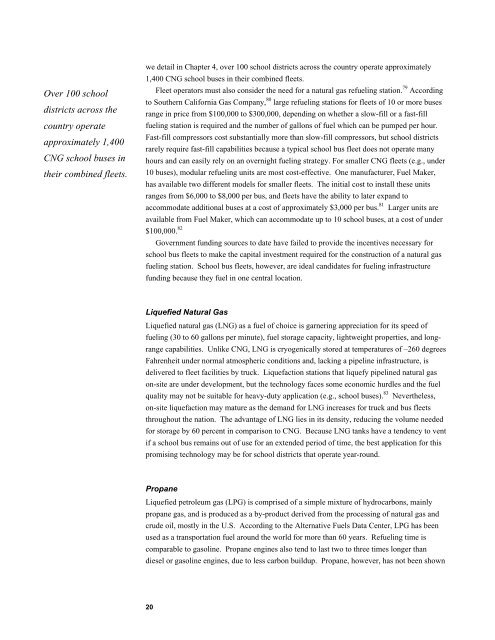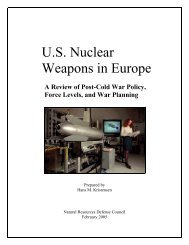NRDC: No Breathing in the Aisles: Diesel Exhaust Inside School ...
NRDC: No Breathing in the Aisles: Diesel Exhaust Inside School ...
NRDC: No Breathing in the Aisles: Diesel Exhaust Inside School ...
Create successful ePaper yourself
Turn your PDF publications into a flip-book with our unique Google optimized e-Paper software.
Over 100 school<br />
districts across <strong>the</strong><br />
country operate<br />
approximately 1,400<br />
CNG school buses <strong>in</strong><br />
<strong>the</strong>ir comb<strong>in</strong>ed fleets.<br />
we detail <strong>in</strong> Chapter 4, over 100 school districts across <strong>the</strong> country operate approximately<br />
1,400 CNG school buses <strong>in</strong> <strong>the</strong>ir comb<strong>in</strong>ed fleets.<br />
Fleet operators must also consider <strong>the</strong> need for a natural gas refuel<strong>in</strong>g station. 79 Accord<strong>in</strong>g<br />
to Sou<strong>the</strong>rn California Gas Company, 80 large refuel<strong>in</strong>g stations for fleets of 10 or more buses<br />
range <strong>in</strong> price from $100,000 to $300,000, depend<strong>in</strong>g on whe<strong>the</strong>r a slow-fill or a fast-fill<br />
fuel<strong>in</strong>g station is required and <strong>the</strong> number of gallons of fuel which can be pumped per hour.<br />
Fast-fill compressors cost substantially more than slow-fill compressors, but school districts<br />
rarely require fast-fill capabilities because a typical school bus fleet does not operate many<br />
hours and can easily rely on an overnight fuel<strong>in</strong>g strategy. For smaller CNG fleets (e.g., under<br />
10 buses), modular refuel<strong>in</strong>g units are most cost-effective. One manufacturer, Fuel Maker,<br />
has available two different models for smaller fleets. The <strong>in</strong>itial cost to <strong>in</strong>stall <strong>the</strong>se units<br />
ranges from $6,000 to $8,000 per bus, and fleets have <strong>the</strong> ability to later expand to<br />
accommodate additional buses at a cost of approximately $3,000 per bus. 81 Larger units are<br />
available from Fuel Maker, which can accommodate up to 10 school buses, at a cost of under<br />
$100,000. 82<br />
Government fund<strong>in</strong>g sources to date have failed to provide <strong>the</strong> <strong>in</strong>centives necessary for<br />
school bus fleets to make <strong>the</strong> capital <strong>in</strong>vestment required for <strong>the</strong> construction of a natural gas<br />
fuel<strong>in</strong>g station. <strong>School</strong> bus fleets, however, are ideal candidates for fuel<strong>in</strong>g <strong>in</strong>frastructure<br />
fund<strong>in</strong>g because <strong>the</strong>y fuel <strong>in</strong> one central location.<br />
Liquefied Natural Gas<br />
Liquefied natural gas (LNG) as a fuel of choice is garner<strong>in</strong>g appreciation for its speed of<br />
fuel<strong>in</strong>g (30 to 60 gallons per m<strong>in</strong>ute), fuel storage capacity, lightweight properties, and longrange<br />
capabilities. Unlike CNG, LNG is cryogenically stored at temperatures of –260 degrees<br />
Fahrenheit under normal atmospheric conditions and, lack<strong>in</strong>g a pipel<strong>in</strong>e <strong>in</strong>frastructure, is<br />
delivered to fleet facilities by truck. Liquefaction stations that liquefy pipel<strong>in</strong>ed natural gas<br />
on-site are under development, but <strong>the</strong> technology faces some economic hurdles and <strong>the</strong> fuel<br />
quality may not be suitable for heavy-duty application (e.g., school buses). 83 Never<strong>the</strong>less,<br />
on-site liquefaction may mature as <strong>the</strong> demand for LNG <strong>in</strong>creases for truck and bus fleets<br />
throughout <strong>the</strong> nation. The advantage of LNG lies <strong>in</strong> its density, reduc<strong>in</strong>g <strong>the</strong> volume needed<br />
for storage by 60 percent <strong>in</strong> comparison to CNG. Because LNG tanks have a tendency to vent<br />
if a school bus rema<strong>in</strong>s out of use for an extended period of time, <strong>the</strong> best application for this<br />
promis<strong>in</strong>g technology may be for school districts that operate year-round.<br />
Propane<br />
Liquefied petroleum gas (LPG) is comprised of a simple mixture of hydrocarbons, ma<strong>in</strong>ly<br />
propane gas, and is produced as a by-product derived from <strong>the</strong> process<strong>in</strong>g of natural gas and<br />
crude oil, mostly <strong>in</strong> <strong>the</strong> U.S. Accord<strong>in</strong>g to <strong>the</strong> Alternative Fuels Data Center, LPG has been<br />
used as a transportation fuel around <strong>the</strong> world for more than 60 years. Refuel<strong>in</strong>g time is<br />
comparable to gasol<strong>in</strong>e. Propane eng<strong>in</strong>es also tend to last two to three times longer than<br />
diesel or gasol<strong>in</strong>e eng<strong>in</strong>es, due to less carbon buildup. Propane, however, has not been shown<br />
20
















